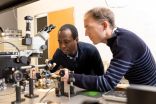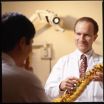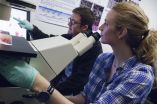(Press-News.org) ANN ARBOR--As if holiday travel isn't stressful enough. Now University of Michigan researchers say we're likely sharing that already overcrowded airline cabin with countless tiny creatures including house dust mites.
"What people might not realize when they board a plane is that they can share the flight with a myriad of microscopic passengers-- including house dust mites--that take advantage of humanity's technological progress for their own benefit," said U-M biologist Pavel Klimov.
"House dust mites can easily travel on an airline passenger's clothes, skin, food and baggage," said Klimov, an assistant research scientist in the U-M Department of Ecology and Evolutionary Biology. "Like humans, they use air travel to visit new places, where they establish new populations, expand their ranges and interact with other organisms through various means."
Air travel likely explains some of the findings of a new genetic study conducted by Klimov and U-M visiting scholar Rubaba Hamid that looked at the connections between house dust mite populations in the United States and South Asia.
They found genetic mutations shared by mites in the U.S. and Pakistan that demonstrate the eight-legged creatures' propensity for intercontinental dispersal, according to a research paper scheduled for online publication Dec. 10 in the journal PLOS ONE.
"What we found suggests that mite populations are indeed linked through migration across continents, though geographic differences still can be detected," Hamid said. "Every time a mite successfully migrates to a new place, it brings its own genetic signature that can be detected in the resident population a long time after the migration event."
The study focused on two medically important mite species, the American and European house dust mite. Both species have global distributions, though the former is more abundant in the U.S.
Ancestors of the two species probably separated from each other nearly 81 million years ago--long before the origin of humans--when they inhabited bird nests. Today, house dust mites are blamed for causing allergic reactions in more than 65 million people worldwide and thrive in the mattresses, sofas and carpets of even the cleanest homes.
Hamid, Klimov and their colleagues examined genetic variation in the group 1 allergen gene from samples of the two mite species collected in the U.S. and Pakistan. The group 1 allergen gene encodes for the most important allergy-causing protein in house dust mites.
An inactive form of this protein is used in clinics worldwide as part of the standard skin-prick test for allergies. Though the test can be inaccurate if it does not include local genetic variants of the allergy-causing protein, geographical variation in group 1 allergen proteins has not been extensively studied in the U.S., Klimov said.
"We need to have a better idea about the diversity of allergenic proteins around the world, and particularly in the United States," he said.
In genetic sequences from American house dust mites (Dermatophagoides farinae), the researchers observed mutations at 14 positions along the length of the group 1 allergen gene.
All but one of the mutations are "silent," meaning they occur at the DNA level without changing the amino acid structure of the protein. Only mutations at the protein level have medical significance because they can change allergenic properties.
"The most unexpected result was the finding that a previously unknown mutation occurred at the active site of the protein at position 197," Klimov said. "This was a rare mutation, found in only a single population of house dust mite in South Asia.
"Our analysis indicates that this mutation might alter the enzyme activity of the protein. But allergenic properties, immune response and cross-reactivity of the protein are unknown at this time," he said. "Follow-up experiments to elucidate these issues are underway in our lab."
INFORMATION:
Hamid is in the Department of Zoology at the Pir Mehr Ali Shah Arid Agriculture University in Rawalpindi, Pakistan. The other authors of the PLOS ONE paper are Muhammad Inam of the University of the Punjab in Lahore, Pakistan; Farhana Riaz Chaudhary of the Pir Mehr Ali Shah Arid Agriculture University; and Barry OConnor of the U-M Department of Ecology and Evolutionary Biology.
The research was supported by the U.S. National Science Foundation, the Higher Education Commission and the International Research Support Initiative Program in
Pakistan, the Ministry of Education and Science of the Russian Federation, and the U.S. National Pediculosis Association.
Pavel Klimov: http://bit.ly/1zwoeSL
Massachusetts General Hospital (MGH) investigators have identified two compounds that appear, in cellular and animal models, to block the cardiac damage caused by the important chemotherapy drug doxorubicin. Their report in the Dec. 10 issue of Science Translational Medicine indicates that inhibiting the action of an enzyme that is key to the generation of cellular energy in mitochondria could prevent doxorubicin-induced damage to cardiac cells without reducing the drug's anti-tumor effects.
"Doxorubicin-induced cardiomyopathy limits the amount of the drug a patient ...
Treating the potentially blinding haze of a scar on the cornea might be as straightforward as growing stem cells from a tiny biopsy of the patient's undamaged eye and then placing them on the injury site, according to mouse model experiments conducted by researchers at the University of Pittsburgh School of Medicine. The findings, published today in Science Translational Medicine, could one day rescue vision for millions of people worldwide and decrease the need for corneal transplants.
According to the National Eye Institute, part of the National Institutes of Heath, ...
Rats that received thyroid hormones had a reduced risk for dangerous heart arrhythmias following a heart attack, according to a new study by a team of medical researchers at New York Institute of Technology.
In the NIH-funded study, published in the Journal of Cardiac Failure, the team found that thyroid hormone replacement therapy significantly reduced the incidence of atrial fibrillation - a specific kind of irregular heartbeat, or arrhythmia -- in the rats, compared to a control group that did not receive the hormones.
The finding could have important implications ...
San Diego, Calif., Dec. 10, 2014 -- Engineers at the University of California, San Diego have demonstrated a new and more efficient way to trap light, using a phenomenon called bound states in the continuum (BIC) that was first proposed in the early days of quantum wave mechanics.
Boubacar Kanté, an assistant professor in electrical and computer engineering at UC San Diego Jacobs School of Engineering, and his postdoctoral researcher Thomas Lepetit described their BIC experiment online in the rapid communication section of journal Physical Review B. The study directly ...
Researchers from North Carolina State University and Qatar University have developed a new "high-entropy" metal alloy that has a higher strength-to-weight ratio than any other existing metal material.
High-entropy alloys are materials that consist of five or more metals in approximately equal amounts. These alloys are currently the focus of significant attention in materials science and engineering because they can have desirable properties.
The NC State research team combined lithium, magnesium, titanium, aluminum and scandium to make a nanocrystalline high-entropy ...
Is it the thought that really counts?
When it comes to giving gift cards, maybe not.
New research from the University of Cincinnati can help even the most thoughtful gift giver avoid the mistake of over-personalization and keep that card from being banished to the bottom of a purse or hidden deep inside a wallet for the next six months.
"Givers often fail to anticipate that the gifts they prefer to give are not necessarily the ones recipients prefer to receive," says Mary Steffel, researcher and assistant professor of marketing in UC's Carl H. Lindner College of Business.
So ...
CORVALLIS, Ore. - Researchers for the first time have developed a method to track through the human body the movement of polycyclic aromatic hydrocarbons, or PAHs, as extraordinarily tiny amounts of these potential carcinogens are biologically processed and eliminated.
PAHs, which are the product of the incomplete combustion of carbon, have been a part of everyday human life since cave dwellers first roasted meat on an open fire. More sophisticated forms of exposure now range from smoked cheese to automobile air pollution, cigarettes, a ham sandwich and public drinking ...
Many children who sustain so-called open bone fractures in the forearm or lower leg can, and do, heal safely without surgery, according to the results of a small study led by investigators at the Johns Hopkins Children's Center.
Open fractures occur when the broken bone protrudes through the skin, causing a puncture wound.
The study, published ahead of print in the Journal of Children's Orthopaedics, shows that when the wound is small -- less ½-inch in diameter -- and the surrounding tissue is free of visible contamination with dirt or debris, children heal well ...
CAMBRIDGE, MA, December 10, 2014 - A team of investigators from the Broad Institute, Massachusetts General Hospital and other leading biomedical research institutions has pinpointed rare mutations in a gene called APOA5 that increase a person's risk of having a heart attack early in life. These mutations disable the APOA5 gene and also raise the levels in the blood of triglyceride-rich lipoproteins, a type of fat. The researchers' findings, together with other recent genetic discoveries -- specifically, the identification of protective mutations in the APOC3 gene that lower ...
Stem cells in early embryos have unlimited potential; they can become any type of cell, and researchers hope to one day harness this rejuvenating power to heal disease and injury. To do so, they must, among other things, figure out how to reliably arrest stem cells in a Peter Pan-like state of indefinite youth and potential. It's clear the right environment can help accomplish this, acting as a sort of Neverland for stem cells. Only now are scientists beginning to understand how.
New collaborative research between scientists at Rockefeller University and Memorial ...




